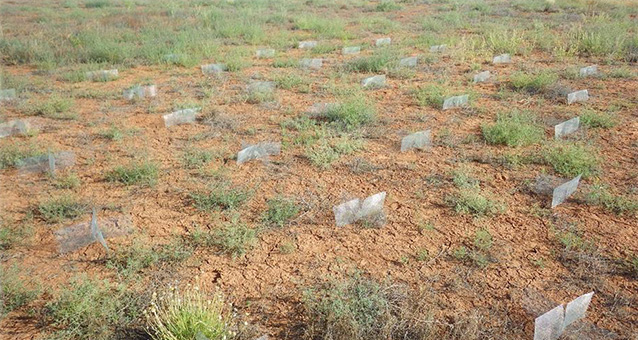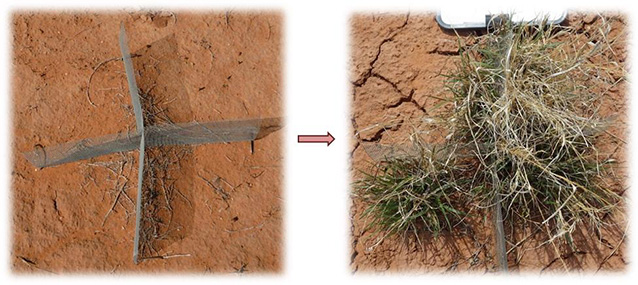Before Canyonlands and Arches national parks were established, decades of heavy livestock grazing in sensitive areas led to a decline in native perennial grasses and biological soil crust. Plant roots and soil crusts act as anchors, holding the sandy soil in place. As these plants and crusts disappeared, wind blew the top layer of soil away. In many large areas, that topsoil is now gone. The parks have begun a project to restore those native grasslands.

NPS/Liz Ballenger
The hard-packed soil left behind has higher clay content, which makes a hostile environment for native bunchgrasses. These conditions make it easy for undesirable non-native species, such as tumbleweed and cheatgrass, to move in.
When grasslands reach this “degraded state” where soil loss and weed invasion are common, they may not recover on their own because the large continuous areas of bare ground are very susceptible to the forces of erosion. High winds in these areas will whip away any beneficial sand, seed, or organic matter that might deposit there. Fixing this problem requires constructing something to interrupt those big, open spaces.

USGS/Becky Mann and NPS/Liz Ballenger
The solution park staff developed might look strange, but it works. They fastened x-shaped screens to the ground in degraded grasslands in The Needles district of Canyonlands National Park and in Salt Valley in Arches National Park. The screens are called “Connectivity Modifiers,” or ConMods because they modify—or break up—the continuous nature of the bare earth. Their shape helps trap windblown soil and prevent erosion, creating a protected environment for plants to take root.
In the fall of 2016, staff seeded the ConMods with a mixture of native perennial grasses that will germinate over the next several years when conditions are right. Perennial grasses will help to hold the soil in place, and put the degraded sites on the road to recovery. Stabilized soil will help the recovery of other native grasses, shrubs, flowering plants, and biological soil crusts, allowing these areas to return to a healthy plant community and habitat for wildlife.
Native plants are vital for the healthy functioning of our grassland ecosystems, and restoring native vegetation will help barren areas resist more degradation. Scientists predict higher temperatures and more frequent and extreme drought events for this region as the climate changes. These changes to our climate will make restoring grasslands more difficult, so the time for action is now.
Last updated: April 29, 2025
